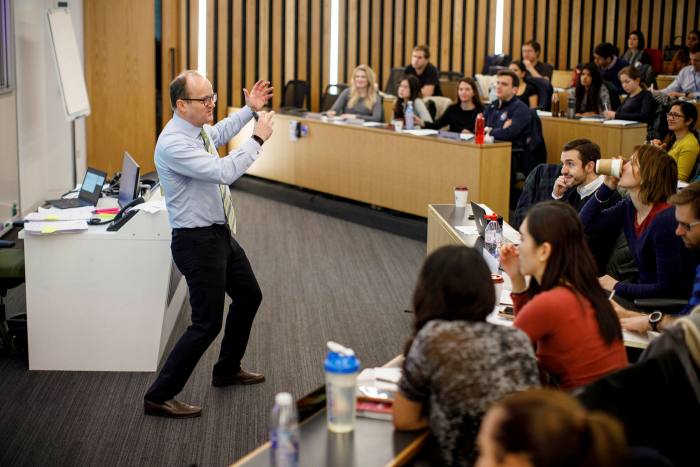FT Masters in Management ranking 2021: methodology and key
Methodology
This is the 17th version of the FT rating of Masters in Management (MiM) programmes.
A file 124 MiM programmes took part in the rating procedure in 2021, up from 114 in 2020. Faculties need to fulfill rigorous criteria in purchase to be suitable. Their programmes need to be total-time, cohort-based mostly and colleges need to be accredited by either AACSB or Equis. Classes need to be directed at college students with very little or no get the job done working experience. The rating addresses typical administration programmes, not specialised types.
The desk is calculated according to facts collected by means of two separate surveys. The 1st is concluded by the organization colleges and the next by alumni who concluded their MiM in 2018.
The FT commonly involves a reaction charge of 20 for every cent of alumni, with a least of 20 responses, for a school to enter the rating calculations. Due to the pandemic, the FT regarded as colleges with a decreased reaction charge. Some seven,400 alumni concluded this year’s survey — a reaction charge of about 29 for every cent.
FT Masters in Management rating 2021 — best 100

Locate out which colleges are in our rating of Masters in Management degrees. Discover how the desk was compiled and browse the rest of our coverage at www.ft.com/mim.
The rating has seventeen criteria. Alumni responses tell seven criteria that with each other lead 58 factors of the ranking’s complete pounds. The remaining ten criteria are calculated from school information and account for 38 factors of the pounds.
For this yr, the complete pounds for the desk is 96 factors. Due to the vacation restrictions induced by the pandemic, the pounds for the international study course working experience group has been minimized. This actions students’ abroad publicity all through their degree.
The latest typical wage of alumni has the best weighting, at 20 factors. Local salaries are converted to US pounds making use of buying electric power parity prices (PPP) provided by the IMF. The salaries of non-profit and public company workers, and total-time college students, are removed. Salaries are normalised by taking away the extremely best and cheapest salaries documented.
Salary enhance is the next most essential criterion, with a weighting of ten factors. It is based mostly on the typical distinction in alumni wage concerning their 1st MiM-stage work immediately after completion and their latest wage, a few decades immediately after completion. 50 % of the pounds is applied to the absolute wage enhance and the other 50 % is applied to the relative share enhance.
Where accessible, facts collected above the past a few decades is employed for alumni criteria. Responses from 2021 carry 50 for every cent of the complete pounds and these from 2020 and 2019 every single account for 25 for every cent. Excluding wage-related criteria, if only two decades of information are accessible, the weighting is split sixty:forty if information are from 2021 and 2020, or 70:thirty if from 2021 and 2019. For wage figures, the weighting is 50:50 for two years’ information, to negate inflation-related distortions.
Data furnished by colleges are employed to measure the variety of educating employees, board members and college students according to gender and nationality and the international achieve of the programme. For gender criteria, colleges with a 50:50 (male: woman) composition receive the best rating.
When calculating international variety, in addition to the share of international college students and school at a school — the figures printed — the FT also considers the proportion of international college students and school by citizenship.
A rating is then calculated for every single school. Initial, Z-scores — formulas that replicate the assortment of scores concerning the best and bottom school — are calculated for every single rating criterion. These scores are then weighted and included with each other to give a ultimate rating. Faculties are ranked according to these scores, developing the FT Masters in Management rating of 2021.
Soon after discounting the colleges that did not fulfill the reaction charge threshold from the alumni survey, a 1st model is calculated making use of all remaining colleges. The school at the bottom is removed and a next model is calculated, and so on until eventually the ultimate rating is achieved.
Other facts in the desk — programme size, the quantity of college students enrolled, in general gratification and the share of college students who undertake internships — does not lead toward the rating. (See the critical to the rating beneath.)
Judith Pizer of Pizer-MacMillan acted as the FT’s databases consultant.
Critical: weights for rating criteria are proven in brackets as factors.
The complete desk pounds provides up to 96 factors.
Salary these days US$: typical wage a few decades immediately after completion (not employed in the rating calculation), US$ PPP equivalent (buying electric power parity. See methodology at ft.com/mim-technique) †*
Weighted wage US$ (20): typical graduate wage a few decades immediately after completion, adjustment for wage versions concerning sectors, US$ PPP equivalent. †*
Salary enhance (ten): typical distinction in alumni wage concerning completion and these days. 50 % of this figure is calculated according to the absolute enhance and 50 % according to the relative share enhance. †*
Benefit for income (five): calculated according to alumni salaries these days, charges and other costs. †*
Job progress (five): calculated according to improvements in the stage of seniority and the size of organization alumni are functioning for concerning completion and today. †*
Aims accomplished (five): the extent to which alumni fulfilled their targets for doing a masters. †*
Professions company rank (five): usefulness of the careers company in supporting scholar recruitment, rated by alumni. †*
Used at a few months % (five): share of the most modern finishing class that found employment inside of a few months of finishing their study course. Figure in brackets is the share of the class for which the school was able to present information. §
Woman school % (five): share of woman school as of April one. ‡
Woman college students % (five): share of gals on the masters programme on March 31. ‡
Women of all ages on board % (one): share of gals on the school advisory board. ‡
Global school % (five): calculated according to the variety of school (on April 1) by citizenship and the share whose citizenship differs from their state of employment — the figure printed in the desk.
Global college students % (five): calculated according to the variety of latest MiM college students by citizenship and the share whose citizenship differs from the state in which they review — the figure in the desk.
Global board % (one): share of the board whose citizenship differed from the school’s home country.
Global mobility (eight): calculated according to improvements in the state of employment of alumni concerning completion and these days. Alumni citizenship is taken into account. †*
Global study course working experience (4): calculated according to whether the most modern finishing masters class carried out exchanges and organization internships, lasting at the very least a month, in international locations other than in which the school is based mostly. Digital experiences are not included. An typical calculation was taken from the 2021 survey and the past two years’ international study course working experience information (2020 and 2019), if accessible. For colleges that have taken part for the 1st time this yr, only information from the 2021 survey were being employed. Due to vacation restrictions induced by the pandemic, some colleges were being unable to present modern information for this group. If you are a prospective scholar, be sure to get in touch with the school to check if they provide review visits and internships abroad. †§
Added languages (one): the quantity of languages required on graduation, excluding English.
Faculty with doctorates % (six): share of school with doctoral degrees at April one.
The types beneath are for facts only and are not employed in the ranking calculations.
Ordinary study course size (months): typical size of the masters programme.
Amount enrolled 2020-21: quantity of college students who enrolled in the 1st yr of the masters programme in the past yr.
Overall gratification: typical evaluation by alumni of the masters study course, scored out of ten. Soon after alumni answered different queries about their masters working experience, together with the high-quality of the school’s careers company, they were being requested to charge their in general gratification, on a ten-issue scale.
Firm internships (%): the share of the final finishing class that undertook internships as part of the programme. §
† Includes information for the latest and one particular or two previous decades in which accessible.
‡ For all gender-related criteria, colleges with a 50:50 (male/woman) composition receive the best rating.
* Data from alumni who concluded their programmes in 2018 included.
§ Completed MiM concerning March one, 2020 and February 28, 2021.







